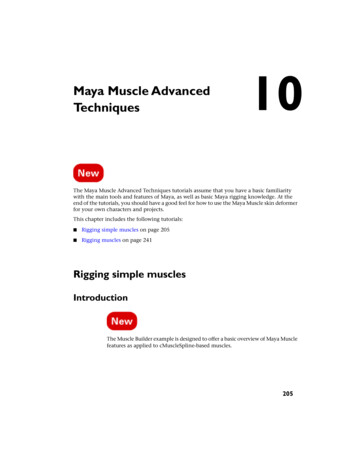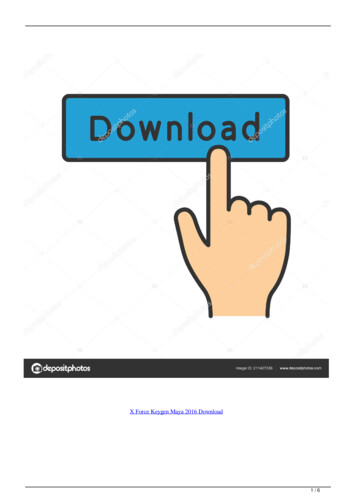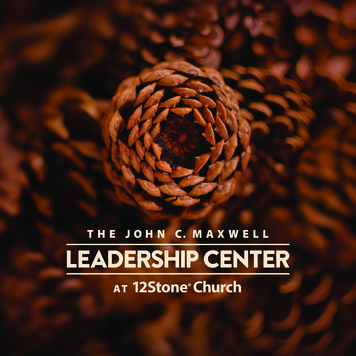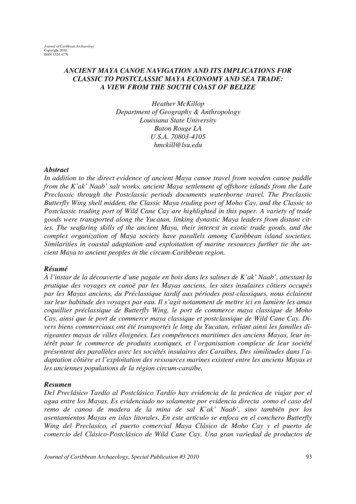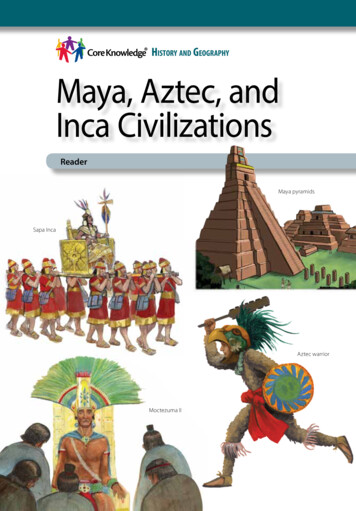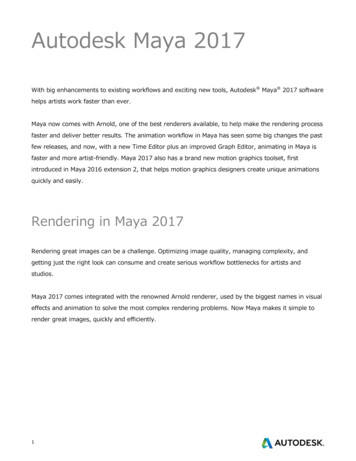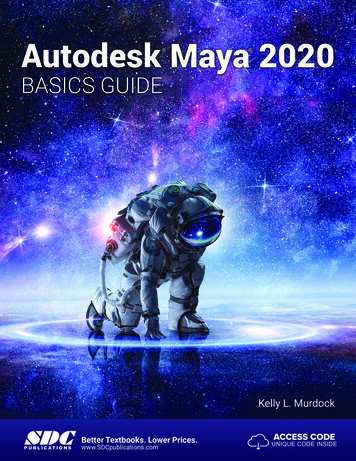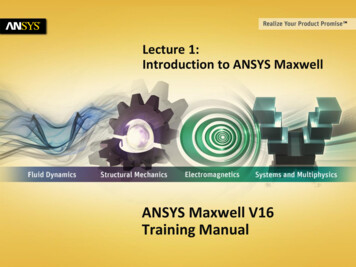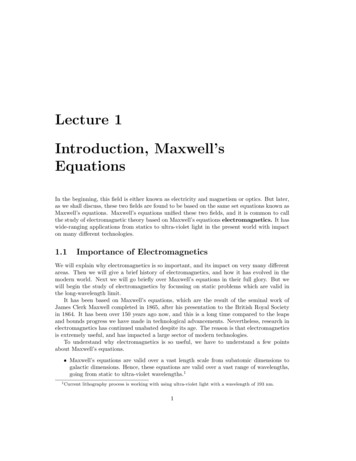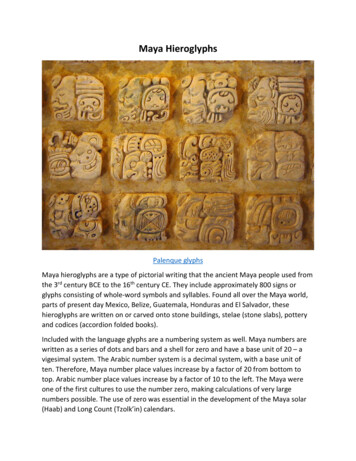
Transcription
Maya HieroglyphsPalenque glyphsMaya hieroglyphs are a type of pictorial writing that the ancient Maya people used fromthe 3rd century BCE to the 16th century CE. They include approximately 800 signs orglyphs consisting of whole-word symbols and syllables. Found all over the Maya world,parts of present day Mexico, Belize, Guatemala, Honduras and El Salvador, thesehieroglyphs are written on or carved onto stone buildings, stelae (stone slabs), potteryand codices (accordion folded books).Included with the language glyphs are a numbering system as well. Maya numbers arewritten as a series of dots and bars and a shell for zero and have a base unit of 20 – avigesimal system. The Arabic number system is a decimal system, with a base unit often. Therefore, Maya number place values increase by a factor of 20 from bottom totop. Arabic number place values increase by a factor of 10 to the left. The Maya wereone of the first cultures to use the number zero, making calculations of very largenumbers possible. The use of zero was essential in the development of the Maya solar(Haab) and Long Count (Tzolk’in) calendars.
Try your hand at writing with Maya hieroglyphs and calculating with Maya numbers!Make your own codexMaterials needed:1.2.3.4.Printed worksheet belowCrayons, markers or colored pencilsScissorsGlue, staples or tapeInstructions:Dresden Codex1. To make a larger codex, print off the worksheet below on ledger sized (11” x 17”) paper.2. Don’t have a large format printer? Make a smaller version printed on standard sized (8.5” x 11”)paper. Or make your own codex using any large paper you have. Recycled paper grocery bagsare a great option!3. Using the simplified syllabary and numbers chart below, write the glyphs for each word abovethe English spelling. Each glyph in the syllabary contains a consonant letter sound linked with avowel sound. Find the letter/sound pairings needed to write each word. You can draw thesyllables next to each other, or connect them side-by-side and below like the example here.When reading the syllables, usethe following vowel sounds:“a” as in father“e” as in set“i” like the ee in see“o” as in hold“u” like the oo in zooVowels in parentheses are silent.4. Next, fill in the numbers to write your phone number andbirthdate, and complete the math problems. Don’t forgetto write your name on your codex in hieroglyphs!5. Cut along the lines under the words and numbers and setthe remaining project aside for the next activity.6. Arrange the two strips back-to-back, with printed sideout and glue, staple or tape each side together.7. Fold in half lengthwise and fold in half again so that thecover page with your name faces out.8. Your codex is complete!For more math fun, try this activity to calculate large numbers using Maya numbers.Maya Math – Multiverse- Space Sciences Laboratory, UC BerkeleyDiscover the glyphs for your Gregorian calendar birthdate written in the Maya Long Count calendarusing this Maya Calendar Converter.
Decorate a drinking vessel the Maya wayMaterials needed:1.2.3.4.Strip from worksheet belowCrayons, markers or colored pencilsScissorsSticky Velcro, glue, staples or tapeInstructions:1. Add your name in hieroglyphs to the end of thedrinking vessel strip.2. Cut it out along the dotted lines and laminate it. Don’tCylindrical Vesselhave laminate? Use clear packaging tape if possible.3. Wrap this strip around your favorite mug or water bottle and attach it to itself with stickyVelcro, glue, staples or tape.4. Your drinking vessel is complete and marked as your own!Learn more about how a drinking cup of a classic Maya noble such as the one pictured above was usedto make delicious chocolate!
Draw the syllables for the followingwords.Ha(water)Ku - k(u)(quetzal[bird])Ba - la - m(a)(jaguar)I - xe - l(e)(moon goddess) Maya numbersSolve these math problems using Mayanumbers.1. Write your phone number using Mayanumbers./ /Write your birth date using Mayanumbers.2. This codexbelongs to: 3.- 4.- Maxwell Museum of Anthropology Here is a standard sequence of Maya hieroglyphs found on ancient pottery that tells who’s pottery it is and what the pottery was used for. Add your name in Maya hieroglyphs to the end, cut it out alongthe dotted lines and laminate it. Attach it to itself with some Velcro and wrap it around a mug or water bottle that you have at home to claim that drinking vessel as your own!
)
Primary Standard Sequence – ChCh’oltiolti and English translationSalutationInitialGlyphDeityHead“his paint” Name ed translation: How do you do ‐ ‐ This is the name tag for (owner’s name) cocoa drinking vesselThe language of Classic Maya texts is an early form or Ch’olti’ and Ch’orti’ from the Ch’olanMaya linguistic familyfamily. Today this language is called “ClassicClassic Mayan”Mayan by some epigraphists(those who decipher glyphs). It was a literary language used for reading and writing, ratherthan for everyday speech, much like Sumerian in Mesopotamia, Latin in Medieval Europe,Sanskrit in India or Literary Chinese in China1.1Coe,Michael D. and Mark Van Stone. 2005. Reading the Maya Glyphs, Thames & Hudson, Second Edition. Pp. 15.
Maya hieroglyphs and mathematics resourceshttps://www.youtube.com/watch?v Ybvb7oy WV0&feature emb logoMaya math th-gameMaya math game and activities from the National Museum of the American chen/docs/Mayan Math.pdfBreaking the Mayan Code Mayan Math lesson plan from -The Exhibition from the Cincinnati Museum Center. Includes exhibition objects, video and drinkingvessel hocolateGum and Chocolate (both products from resources in the Mesoamerican rain forest) chemistryexperiment from NISE-National Informal STEM Education files/public/Ancient%20Egypt.pdfEgyptian hieroglyphs activity for comparative iles/public/Using%20symbols.pdfPrimer on symbols.
Lulu enjoying a cup of hot cacao!
Maya Hieroglyphs . Palenque glyphs. Maya hieroglyphs are a type of pictorial writing that the ancient Maya people used from the 3rd century BCE to the 16th century CE. They include approximately 800 signs or glyphs consisting of whole-word symbols and s
